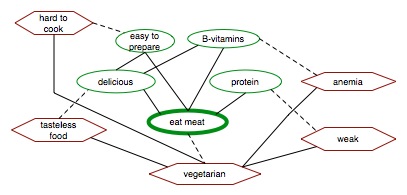PHIL 226, Exercise 1, Value Map 1
Introduction
This assignment is due Thursday, Sept. 27, 8:30., in class. It is worth 7 marks out of 100 for the course.
Late assignments will be accepted until Oct. 2, in class, but will receive a maximum of 5 marks.
After Oct. 2 at 8:30, assignments will not be accepted, except for documented reasons of illlness or family emergency.
Instructions
Students will analyze an important issue in biomedical ethics using value maps, a kind of cognitive-affective map.
Choose ONE of the two topics below.
Hand in a single page, two-sided, consisting of:
- Your last name, first name, student number.
- Title: topic question.
- Value map of the yes view.
- Value map of the no view.
- Discussion, 150-200 words, of the similarities and differences between the yes and no views. Provide a word count.
- Conclusion, 50-100 words, on why you think the yes map or the no map is ethically superior
Topics
1. Is doctor-assisted suicide morally right? Yes or no.
2. Is male circumcision morally right? Yes or no.
Drawing Value Maps
Instructions for drawing cognitive-affective maps are available here.
Each map (maximum 1/2 page) must include:
- A node for the topic, e.g ASSISTED SUICIDE, CIRCUMCISION. This will be positive in the yes map and negative in the no map.
- At least 5 positive concepts, represented by ovals.
- At least 5 negative concepts, represented by hexagons.
- Marker of *C* for consequences or *R* for rights for all positive and negative concepts.
- At least one concept marked *C* and at least one marked *R*.
- At least 3 positive support links between concepts, represented by straight lines.
- At least 2 negative conflict links between concepts, represented by dotted lines.
- Green circles and red hexagons, if you use colour (optional).
- Support for a positive concept (oval) by complimenting it (solid line) with other positive elements.
- Support for a positive concept (oval) by having it conflict (dotted line) with a negative concept (hexagon).
- Counter-support against negative elements (hexagon) by solid lines to other negative elements or dotted lines to positive elements.
Tools for drawing value maps.
- EMPATHICA will be the easiest for many students. Known bugs: does not work with some laptops. Better to use the downloadable version since the Google ap may become unavailable.
- Any computer drawing program, e.g. Microsoft Office, OpenOffice, OmniGraffle, Illustrator, etc.
- Hand drawing - a stencil will help.
DO NOT:
- Confuse emotionally positive and negative concepts, or complimentary and conflicting links.
- Have the same node both positive and negative.
- Have nodes that are completely unconnected to other nodes.
- Have connections that don't make sense, e.g. having LOVE OF ANIMALS linked supportively with ANIMAL SUFFERING.
- Present both the pro and con side in the same map.
Marking
Each value map will be worth 2.5 marks.
The discussion will be worth 1 mark, and the conclusion 1 mark.
Example
1. Pro-vegetarian value map

2. Anti-vegetarian value map

Paul
Thagard
Computational Epistemology
Laboratory.
This page updated Sept. 26, 2012


